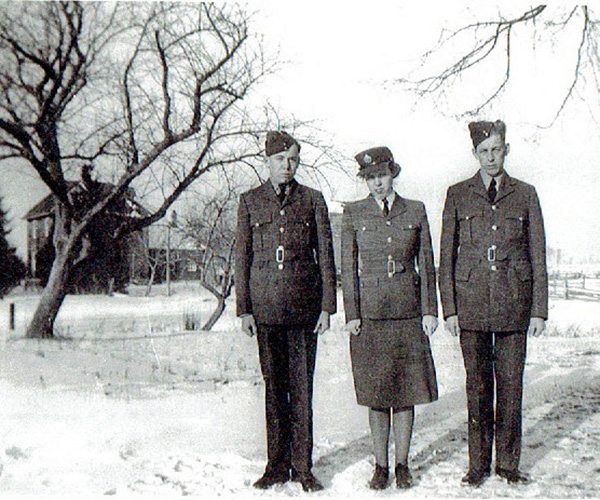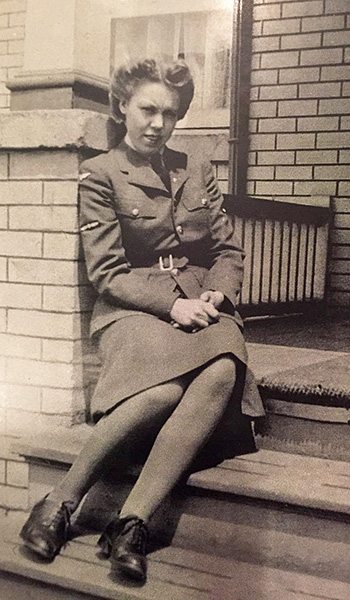Home »

Mysterious bracelet hints at love story
By Elinor Florence
Around Valentine’s Day, my thoughts turn once again to this mysterious bracelet and whether it was truly symbolic of a long-lost love story.
The mystery surfaced more than four years ago, after Emily Tucker of North Battleford, Saskatchewan sent me this photograph of a bracelet bearing the name J. M. J. Barnes on one side, and the Royal Canadian Air Force crest on the other side (pictured above and below).
 She found this bracelet in her uncle’s effects after he died, but she had no idea where it came from.
She found this bracelet in her uncle’s effects after he died, but she had no idea where it came from.
Her uncle was Elijah (Lige) Scargall, brother of her father Aner. Both Lige and Aner were born in Lincolnshire and came to Saskatchewan with their family when they were young. The two boys were from a family of twelve. Emily’s father Aner also enlisted, but was rejected for health reasons.

Lige served as ground crew in the RCAF. He married late in life and had no children, so that’s why Emily inherited his effects.
Emily knows very little about Lige’s service overseas. She recalls her family receiving letters from him when he was in Europe, bearing lots of holes cut out by the censors. And she remembers that he was in Germany after the war ended, because he brought home some horrendous pictures of the death camps.
When she sorted out his effects, Emily generously decided to pass the bracelet along to J. M. J. Barnes herself, or a family member. Because I write a regular online blog called Wartime Wednesdays, she asked for my help.
Over the years, I used all my sleuthing skills to find the bracelet’s owner.
I learned that these souvenir identity bracelets were fairly common in wartime, made in a variety of gold or silver metal, and don’t have much value in today’s marketplace.
The bracelet bears the number W301958, the name “Barnes, J.M.J.” and the date: January 10, 1942. On the opposite side is the RCAF crest.
First I confirmed that the W in front of the number means it belonged to a woman, a member of the RCAF Women’s Division.
Because I had her service number, Veterans Affair Canada was able to tell me that her name was Jean Muriel Jane Barnes. It wouldn’t release any other information because I wasn’t a family member.
I didn’t know whether Jean was still living. In vain did I search the Internet for her name, hoping that a newspaper story about her might surface, or even an obituary.
I posted about her on my own Wartime Wednesdays blog, plus various websites and Facebook groups, hoping someone might recognize the name.
I contacted the RCAF Airwomen’s Association, but they only have records of women who served after the war.
Last year, the story took an even stranger turn when a group of music students at the Banff School of Fine Arts stumbled across my blog and asked my permission to create a performance piece about the mysterious bracelet and its owner!
As the years passed, I began to lose heart.
Finally, in one last-ditch attempt, I wrote a brief item and sent it to the Legion Magazine, where it was posted in The Lost Trails section.
And who should read the item but Jean’s youngest brother and only surviving sibling, 88-year-old Jack Barnes of Cambridge, Ontario!
Jack said he was astonished to read his sister’s name in the magazine and learn that someone was looking for her, after all these years!
Sadly, Jean died in 1999 at the age of 79, but Jack and his two sons, Cory and Ron Barnes, were happy to provide me with some photographs of Jean, and the story of her life.

Jean’s parents moved to Saskatchewan from rural Ontario in the early 1900s looking for work. Her father Norman Barnes was employed as a teamster. He met Mary Beatty in Regina, and they married and tried homesteading near Mazenod in southern Saskatchewan before a succession of crop failures forced them to give up the prospect and return to Ontario in December 1928.
Before they did, their first seven children were born in Saskatchewan. Jean Muriel Janet (not Jane, but Janet – Veterans Affairs had that part wrong) Barnes was born on the farm on May 6, 1920. She was the eldest daughter, with two older brothers. Four younger siblings soon followed. As the oldest daughter, Jean naturally became her mother’s little helper.
When Jean was eight years old, the family returned to Ontario and settled on another farm, near her father’s hometown of Elmville. After they returned to Ontario, the family had another three children, for a total of 10.
Jack was the youngest of the ten siblings, and he remembers that Jean was a loving older sister. “Jean always had a little one parked on her hip,” he told me in a telephone conversation.
Jean lived on the farm until she was sixteen years old, and finished her Grade 9. She then went to Toronto to work for her uncle, with the intention of going to high school. But the price to register for school was $16, and she didn’t have the money. Instead, she worked as a housekeeper and did a variety of other odd jobs.
 On January 10, 1942 (the date commemorated on the bracelet) Jean joined the Women’s Division of the Royal Canadian Air Force. Her family was very proud to see her in her smart blue uniform!
On January 10, 1942 (the date commemorated on the bracelet) Jean joined the Women’s Division of the Royal Canadian Air Force. Her family was very proud to see her in her smart blue uniform!
Her first posting after enlisting was to Guelph, Ontario for a cookery course from January to March 1942. Her second posting was to the air training base in St. Hubert, Quebec. At the time, the British Commonwealth Air Training Program was operating dozens of training airports across the country, for tens of thousands of aircrews from every Commonwealth country.
The photo to the left of Jean standing beside an old car was probably taken on one of her visits home to the farm, complete with the family dog.
Two of Jean’s brothers were also serving in the air force: Melbourne Barnes is here on the left, and Stan Barnes on the right (in below photo).

 From Quebec, Jean was sent west to the province of her birth and was stationed at the air training base in North Battleford, Saskatchewan.
From Quebec, Jean was sent west to the province of her birth and was stationed at the air training base in North Battleford, Saskatchewan.
After leaving Saskatchewan, she spent the last few months of the war, from May to August 1945, at the air training base in Paulson, Manitoba.
From there she was sent to Winnipeg until November 22, 1945 when she was honourably discharged. Like so many other women who served, Jean loved her four years in the air force.
After her discharge, she settled in Toronto. It wasn’t until two decades after the war ended that she married Vic Blount. Although it was a happy marriage, by then it was too late for the couple to have children of their own.
 Her Jean’s husband died in 1992, she moved to Cambridge, Ontario to be near her brother Jack and his wife Betty. She died in November 1999 and is buried in Mississauga, Ontario.
Her Jean’s husband died in 1992, she moved to Cambridge, Ontario to be near her brother Jack and his wife Betty. She died in November 1999 and is buried in Mississauga, Ontario.
According to her brother: “Jean had a quiet, loving nature. She always had a very pleasant way with everyone, especially little ones. She was my favourite sister. She helped our parents throughout their lives in many ways, and helped them to remain comfortable in their own home late into life. Jean was always very generous with her helping hands.”
Jack himself became a woodworker in 1946, and retired in 1989. He then made woodcarving his hobby. He carved an entire collection of horses, complete with harnesses attached to sleighs, wagons, carts and more.
Jack’s wife Betty died recently, and he has been very busy cleaning out his house in Cambridge. So it was fortunate that he spared a few minutes to read the Legion Magazine and discover the item about his sister’s bracelet!
Emily Tucker wasted no time in sending him the bracelet, and Jack was thrilled to receive this final memento of his sister’s life. Pictured below he is at home in Cambridge, holding the bracelet.
He wrote a thank you letter to Emily Tucker, and another one to me.
In his letter to me, he said: “This has been a very exciting event for me. I’m so grateful for all you have done. I’m thinking you got a lot of satisfaction yourself, since it finally came to a positive end.”
Yes, it was very satisfying for me to see the lost bracelet finally returned!
The burning question is why Lige Scargall was in possession of Jean’s bracelet. Unfortunately, neither Jack nor Emily has any idea how this came about.
We don’t have either of their service records, so we don’t know their exact movements during the war. People who served in the air force got shifted around a lot, and with very little warning.
 But we do know that Lige was from North Battleford, and that Jean served in North Battleford during the war.
But we do know that Lige was from North Battleford, and that Jean served in North Battleford during the war.
Being the incurable romantic that I am, I think they must have had a romance or at the very least, a friendship. Perhaps Lige received the bracelet as a memento of their time together. Or perhaps the kind-hearted Jean gave it to him as a good luck charm before he headed overseas.
In wartime days, communication was difficult. Perhaps in spite of their best intentions, Jean and Lige lost touch.
After the war, Jean returned to Ontario and Lige moved to Calgary, where he worked in the construction industry and eventually married a woman named Mary. They never had children, either. Lige died in 1977 and his ashes are buried in North Battleford.
I do think it is interesting that both Jean and Lige remained single for many years after the war, and Lige kept the bracelet among his possessions until he died.
Was one or both of them carrying a torch for the long-lost lover?
Happy Valentine’s Day to lovers everywhere, past and present!
To see my Valentine’s Day column last year, with photos of some wonderful wartime weddings, click HERE.

– Career journalist and bestselling author Elinor Florence of Invermere has written two wartime books. Her novel Bird’s Eye View tells the story of an idealistic Saskatchewan farm girl who joins the Royal Canadian Air Force and becomes an interpreter of aerial photographs. My Favourite Veterans is a non-fiction collection of interviews whose stories appeared previously on e-KNOW, including Cranbrook’s own Bud Abbott.
Elinor’s new novel Wildwood, about pioneer life in the Peace River, Alberta region, will appear in February 2018. It is available for pre-order now at a reduced price on Amazon. For more information about all three books, visit Elinor’s website at www.elinorflorence.com or call her at 250-342-1621.







